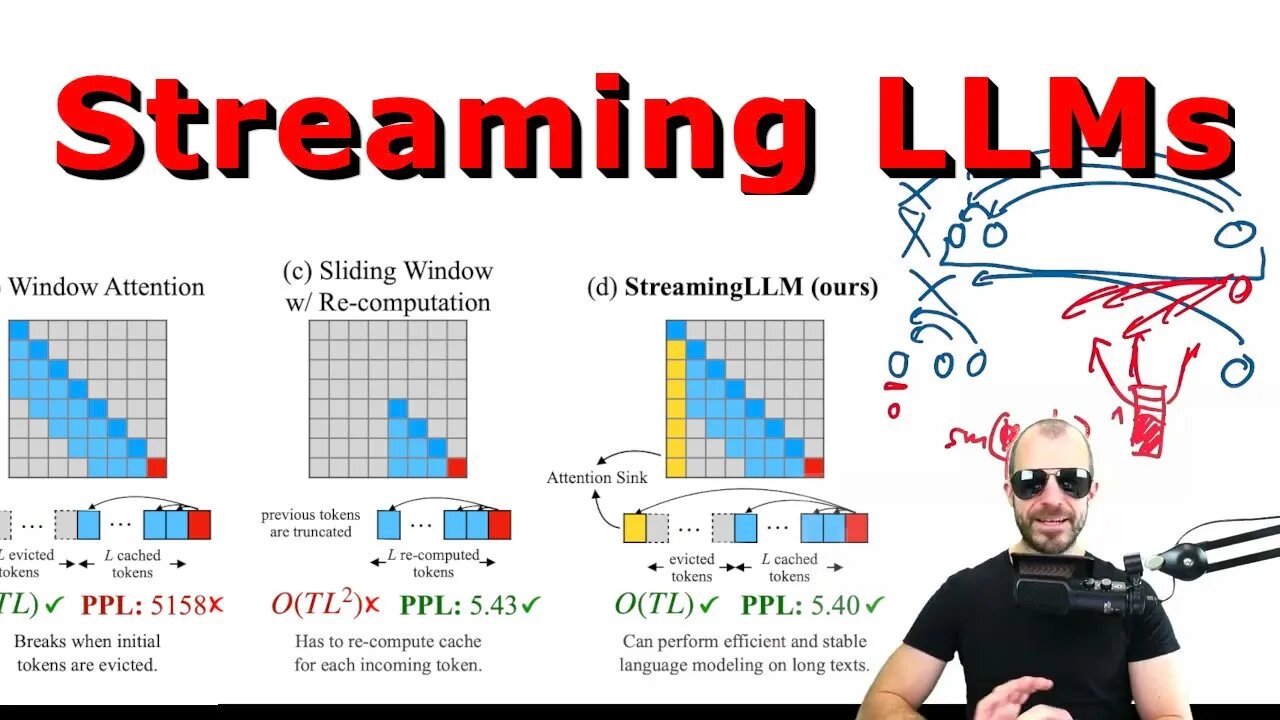Premium Only Content

Efficient Streaming Language Models with Attention Sinks (Paper Explained)
#llm #ai #chatgpt
How does one run inference for a generative autoregressive language model that has been trained with a fixed context size? Streaming LLMs combine the performance of windowed attention, but avoid the drop in performance by using attention sinks - an interesting phenomenon where the token at position 0 acts as an absorber of "extra" attention.
OUTLINE:
0:00 - Introduction
1:20 - What is the problem?
10:30 - The hypothesis: Attention Sinks
15:10 - Experimental evidence
18:45 - Streaming LLMs
20:45 - Semantics or position?
22:30 - Can attention sinks be learned?
27:45 - More experiments
30:10 - Comparison to Big Bird
Paper: https://arxiv.org/abs/2309.17453
Abstract:
Deploying Large Language Models (LLMs) in streaming applications such as multi-round dialogue, where long interactions are expected, is urgently needed but poses two major challenges. Firstly, during the decoding stage, caching previous tokens' Key and Value states (KV) consumes extensive memory. Secondly, popular LLMs cannot generalize to longer texts than the training sequence length. Window attention, where only the most recent KVs are cached, is a natural approach -- but we show that it fails when the text length surpasses the cache size. We observe an interesting phenomenon, namely attention sink, that keeping the KV of initial tokens will largely recover the performance of window attention. In this paper, we first demonstrate that the emergence of attention sink is due to the strong attention scores towards initial tokens as a ``sink'' even if they are not semantically important. Based on the above analysis, we introduce StreamingLLM, an efficient framework that enables LLMs trained with a finite length attention window to generalize to infinite sequence lengths without any fine-tuning. We show that StreamingLLM can enable Llama-2, MPT, Falcon, and Pythia to perform stable and efficient language modeling with up to 4 million tokens and more. In addition, we discover that adding a placeholder token as a dedicated attention sink during pre-training can further improve streaming deployment. In streaming settings, StreamingLLM outperforms the sliding window recomputation baseline by up to 22.2x speedup. Code and datasets are provided at this https URL.
Authors: Guangxuan Xiao, Yuandong Tian, Beidi Chen, Song Han, Mike Lewis
Links:
Homepage: https://ykilcher.com
Merch: https://ykilcher.com/merch
YouTube: https://www.youtube.com/c/yannickilcher
Twitter: https://twitter.com/ykilcher
Discord: https://ykilcher.com/discord
LinkedIn: https://www.linkedin.com/in/ykilcher
If you want to support me, the best thing to do is to share out the content :)
If you want to support me financially (completely optional and voluntary, but a lot of people have asked for this):
SubscribeStar: https://www.subscribestar.com/yannickilcher
Patreon: https://www.patreon.com/yannickilcher
Bitcoin (BTC): bc1q49lsw3q325tr58ygf8sudx2dqfguclvngvy2cq
Ethereum (ETH): 0x7ad3513E3B8f66799f507Aa7874b1B0eBC7F85e2
Litecoin (LTC): LQW2TRyKYetVC8WjFkhpPhtpbDM4Vw7r9m
Monero (XMR): 4ACL8AGrEo5hAir8A9CeVrW8pEauWvnp1WnSDZxW7tziCDLhZAGsgzhRQABDnFy8yuM9fWJDviJPHKRjV4FWt19CJZN9D4n
-
 LIVE
LIVE
Drew Hernandez
21 hours agoCANDACE OWENS / TPUSA STALEMATE & DC PIPE BOMBER CAPTURED?!
907 watching -
 12:31
12:31
Robbi On The Record
5 hours ago $2.52 earnedWhy Nothing Feels Real Anymore | The Science, Culture, and Spiritual War Behind the Fog
18.6K7 -
 18:42
18:42
Navy Media
5 hours agoHouthis ATTACK the Wrong U.S. Fighter Jet – Then THIS Happened…
18.9K26 -
 40:24
40:24
MetatronGaming
1 day agoSomething is REALLY Wrong with this apartment...
14.4K2 -
 LIVE
LIVE
SpartakusLIVE
4 hours agoHUGE NEW UPDATE - Aim Assist NERF, New META, New MOVEMENT || #1 King of Content
437 watching -
![battlefield 6 with the crew! [RGMT CONTENT Mgr. | RGMT GL | GZW CL]](https://1a-1791.com/video/fwe2/7f/s8/6/w/D/y/F/wDyFz.0kob.18.jpg) 2:32:26
2:32:26
XDDX_HiTower
3 hours ago $1.39 earnedbattlefield 6 with the crew! [RGMT CONTENT Mgr. | RGMT GL | GZW CL]
20.3K -
 2:28:57
2:28:57
Nikko Ortiz
4 hours agoVirtual Reality Milsim... | Rumble LIVE
27.9K4 -
 LIVE
LIVE
StevieTLIVE
3 hours agoNEW UPDATE Warzone WINS w/ The Fellas
66 watching -
 9:00:32
9:00:32
Dr Disrespect
13 hours ago🔴LIVE - DR DISRESPECT - WARZONE x BLACK OPS 7 - SEASON 1 INTEGRATION
147K7 -
 1:25:00
1:25:00
Sam Tripoli
5 hours ago $3.14 earnedPunch Drunk Sports LIVE!
20K2